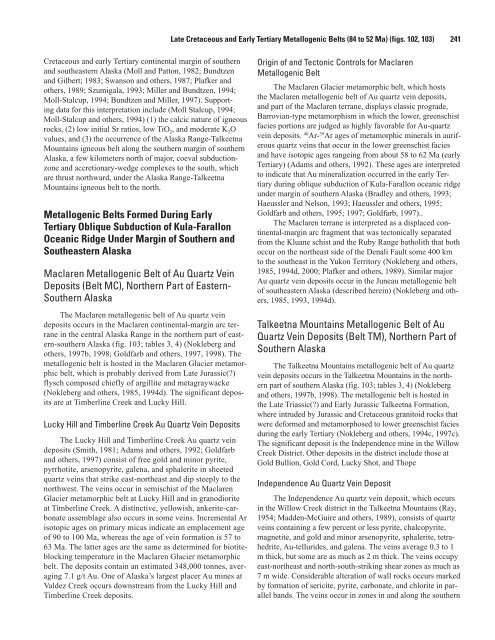USGS Professional Paper 1697 - Alaska Resources Library
USGS Professional Paper 1697 - Alaska Resources Library
USGS Professional Paper 1697 - Alaska Resources Library
Create successful ePaper yourself
Turn your PDF publications into a flip-book with our unique Google optimized e-Paper software.
Cretaceous and early Tertiary continental margin of southern<br />
and southeastern <strong>Alaska</strong> (Moll and Patton, 1982; Bundtzen<br />
and Gilbert; 1983; Swanson and others, 1987; Plafker and<br />
others, 1989; Szumigala, 1993; Miller and Bundtzen, 1994;<br />
Moll-Stalcup, 1994; Bundtzen and Miller, 1997). Supporting<br />
data for this interpretation include (Moll Stalcup, 1994;<br />
Moll-Stalcup and others, 1994) (1) the calcic nature of igneous<br />
rocks, (2) low initial Sr ratios, low TiO 2, and moderate K 2O<br />
values, and (3) the occurrence of the <strong>Alaska</strong> Range-Talkeetna<br />
Mountains igneous belt along the southern margin of southern<br />
<strong>Alaska</strong>, a few kilometers north of major, coeval subductionzone<br />
and accretionary-wedge complexes to the south, which<br />
are thrust northward, under the <strong>Alaska</strong> Range-Talkeetna<br />
Mountains igneous belt to the north.<br />
Metallogenic Belts Formed During Early<br />
Tertiary Oblique Subduction of Kula-Farallon<br />
Oceanic Ridge Under Margin of Southern and<br />
Southeastern <strong>Alaska</strong><br />
Maclaren Metallogenic Belt of Au Quartz Vein<br />
Deposits (Belt MC), Northern Part of Eastern-<br />
Southern <strong>Alaska</strong><br />
The Maclaren metallogenic belt of Au quartz vein<br />
deposits occurs in the Maclaren continental-margin arc terrane<br />
in the central <strong>Alaska</strong> Range in the northern part of eastern-southern<br />
<strong>Alaska</strong> (fig. 103; tables 3, 4) (Nokleberg and<br />
others, 1997b, 1998; Goldfarb and others, 1997, 1998). The<br />
metallogenic belt is hosted in the Maclaren Glacier metamorphic<br />
belt, which is probably derived from Late Jurassic(?)<br />
flysch composed chiefly of argillite and metagraywacke<br />
(Nokleberg and others, 1985, 1994d). The significant deposits<br />
are at Timberline Creek and Lucky Hill.<br />
Lucky Hill and Timberline Creek Au Quartz Vein Deposits<br />
The Lucky Hill and Timberline Creek Au quartz vein<br />
deposits (Smith, 1981; Adams and others, 1992; Goldfarb<br />
and others, 1997) consist of free gold and minor pyrite,<br />
pyrrhotite, arsenopyrite, galena, and sphalerite in sheeted<br />
quartz veins that strike east-northeast and dip steeply to the<br />
northwest. The veins occur in semischist of the Maclaren<br />
Glacier metamorphic belt at Lucky Hill and in granodiorite<br />
at Timberline Creek. A distinctive, yellowish, ankerite-carbonate<br />
assemblage also occurs in some veins. Incremental Ar<br />
isotopic ages on primary micas indicate an emplacement age<br />
of 90 to 100 Ma, whereas the age of vein formation is 57 to<br />
63 Ma. The latter ages are the same as determined for biotiteblocking<br />
temperature in the Maclaren Glacier metamorphic<br />
belt. The deposits contain an estimated 348,000 tonnes, averaging<br />
7.1 g/t Au. One of <strong>Alaska</strong>’s largest placer Au mines at<br />
Valdez Creek occurs downstream from the Lucky Hill and<br />
Timberline Creek deposits.<br />
Late Cretaceous and Early Tertiary Metallogenic Belts (84 to 52 Ma) (figs. 102, 103) 241<br />
Origin of and Tectonic Controls for Maclaren<br />
Metallogenic Belt<br />
The Maclaren Glacier metamorphic belt, which hosts<br />
the Maclaren metallogenic belt of Au quartz vein deposits,<br />
and part of the Maclaren terrane, displays classic prograde,<br />
Barrovian-type metamorphism in which the lower, greenschist<br />
facies portions are judged as highly favorable for Au-quartz<br />
vein deposits. 40Ar-39Ar ages of metamorphic minerals in auriferous<br />
quartz veins that occur in the lower greenschist facies<br />
and have isotopic ages rangeing from about 58 to 62 Ma (early<br />
Tertiary) (Adams and others, 1992). These ages are interpreted<br />
to indicate that Au mineralization occurred in the early Tertiary<br />
during oblique subduction of Kula-Farallon oceanic ridge<br />
under margin of southern <strong>Alaska</strong> (Bradley and others, 1993;<br />
Haeussler and Nelson, 1993; Haeussler and others, 1995;<br />
Goldfarb and others, 1995; 1997; Goldfarb, 1997)..<br />
The Maclaren terrane is interpreted as a displaced continental-margin<br />
arc fragment that was tectonically separated<br />
from the Kluane schist and the Ruby Range batholith that both<br />
occur on the northeast side of the Denali Fault some 400 km<br />
to the southeast in the Yukon Territory (Nokleberg and others,<br />
1985, 1994d, 2000; Plafker and others, 1989). Similar major<br />
Au quartz vein deposits occur in the Juneau metallogenic belt<br />
of southeastern <strong>Alaska</strong> (described herein) (Nokleberg and others,<br />
1985, 1993, 1994d).<br />
Talkeetna Mountains Metallogenic Belt of Au<br />
Quartz Vein Deposits (Belt TM), Northern Part of<br />
Southern <strong>Alaska</strong><br />
The Talkeetna Mountains metallogenic belt of Au quartz<br />
vein deposits occurs in the Talkeetna Mountains in the northern<br />
part of southern <strong>Alaska</strong> (fig. 103; tables 3, 4) (Nokleberg<br />
and others, 1997b, 1998). The metallogenic belt is hosted in<br />
the Late Triassic(?) and Early Jurassic Talkeetna Formation,<br />
where intruded by Jurassic and Cretaceous granitoid rocks that<br />
were deformed and metamorphosed to lower greenschist facies<br />
during the early Tertiary (Nokleberg and others, 1994c, 1997c).<br />
The significant deposit is the Independence mine in the Willow<br />
Creek District. Other deposits in the district include those at<br />
Gold Bullion, Gold Cord, Lucky Shot, and Thope<br />
Independence Au Quartz Vein Deposit<br />
The Independence Au quartz vein deposit, which occurs<br />
in the Willow Creek district in the Talkeetna Mountains (Ray,<br />
1954; Madden-McGuire and others, 1989), consists of quartz<br />
veins containing a few percent or less pyrite, chalcopyrite,<br />
magnetite, and gold and minor arsenopyrite, sphalerite, tetrahedrite,<br />
Au-tellurides, and galena. The veins average 0.3 to 1<br />
m thick, but some are as much as 2 m thick. The veins occupy<br />
east-northeast and north-south-striking shear zones as much as<br />
7 m wide. Considerable alteration of wall rocks occurs marked<br />
by formation of sericite, pyrite, carbonate, and chlorite in parallel<br />
bands. The veins occur in zones in and along the southern
















